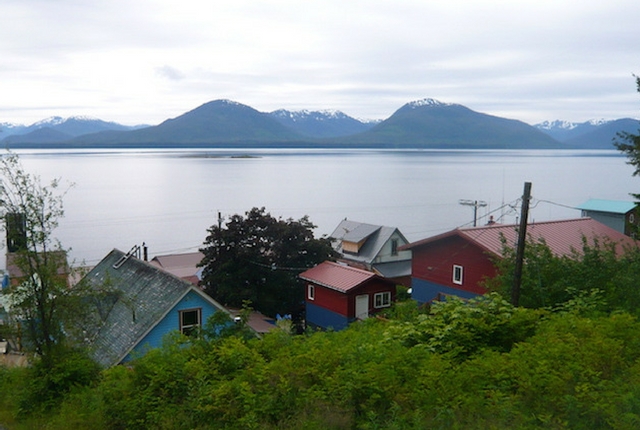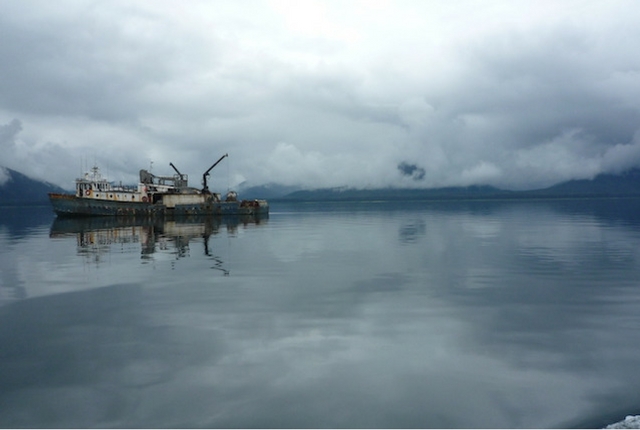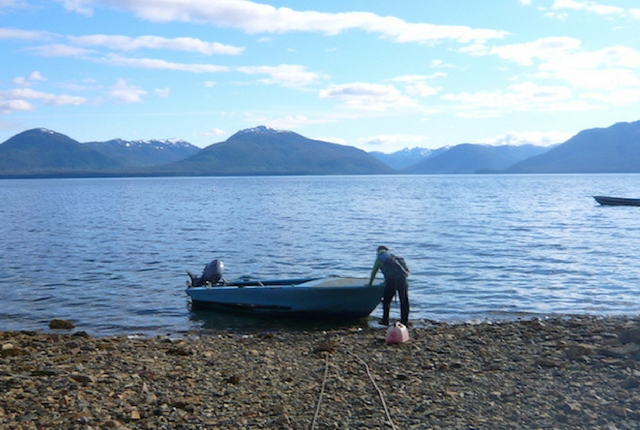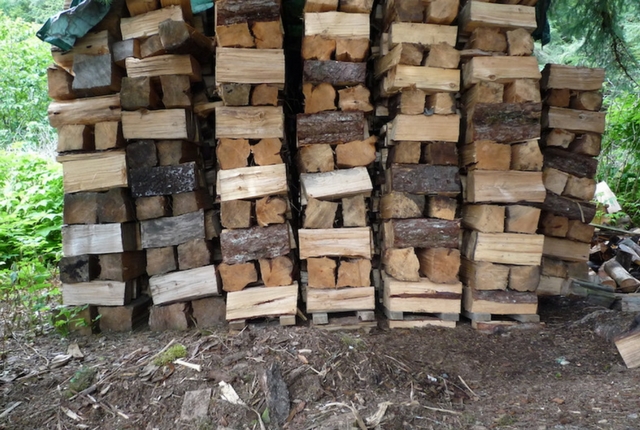
There it was: a wall of pure Alaskan wilderness. Evergreen trees rising up, up, up like a never-ending IMAX screen. My little six-seat plane felt like it was barely edging over this tableau as it chugged above the treetops. The motor roared at maximum effort, pulling me farther away from any signs of civilization. The city of Juneau became a small glittering dot behind me, enfolded by evergreens, and ahead was nothing but trees, jagged rocks, and churning waters. I had one single thought: What in the hell have I done?
Taken my little urban princess self and dropped her straight into the wild, that’s what.
B.A.: Before Alaska
Here’s a snapshot of me at 23: dark, glossy bob, giant sunglasses, rhinestone baubles, and miniature Louis Vuitton purse against the New York City skyline. My worldview was based on a cocktail of “Sex and the City” and “Vogue.” I worshipped at the altar of high fashion. At the time, my proudest accomplishment was being photographed for a Japanese magazine during fashion week. And my favorite reply to anything was singing the word “fabulous” — as in “faaaaaabyoooouulosss.” I considered myself worldly (after all, I had traveled extensively through Europe and Latin America), but my version of travel was puddle-hopping between cities, avoiding anything that wasn’t paved road.
How exactly did this girl and her lipgloss end up in remote Alaska? In short: my dad. My parents had what I called a “Green Acres” marriage. My mother was a city girl raised in a Latin American capital and my father was a world explorer with an Indiana Jones complex. It’s probably not surprising to hear they’re now divorced. When I was 12, they shook apart. I remained with my mother near an urban metropolis, but my father found the most remote corner of the U.S. to camp out: a little Alaskan village called Tenakee Springs. We had stayed in touch, but mostly at a distance. Now he was demanding his one and only daughter come visit for two weeks. And with a giant, dramatic sigh, I acquiesced.
Trip Prep, or What Not to Bring to Alaska

What does one bring to Alaska? I can tell you what not to bring, which is everything my closet contained back then. I had an entire wardrobe comprised of spindly stilettos and reflective dresses. How many silver lame frocks does one person need? I was sure the answer was, “One more than one currently owns.”
But even I knew I had to make some emergency purchases if I was to survive the elements. At the top of my shopping list was something called “pants.” I had an ultra-feminine, pants-free wardrobe of miniskirts, sundresses, and leather pencil skirts. My solution in the dead of winter was to wear two sets of tights instead of settling for a pair of trousers.
So I purchased two sets of jeans, which already made me feel incredibly rugged. My other purchase was a pair of what I thought were hiking boots, but could more accurately be described as ankle booties. That was about as butched up as I got.
Other items that went into my suitcase included a 10-pack of seaweed masks and ballet slippers. (I was determined to keep up my “fitness regime” of plies and pirouettes.) I assumed Alaska would be dull, so I’d have plenty of time to workout and beautify. As I prepped for the trip, I tried to think of Alaska like a far more boring Canyon Ranch-style retreat, dubbing it “Spa-laska,” to my friends.
Tenakee Springs: A Population in the Double Digits

My little seaplane banked down, bumped along the water, and chugged into place next to a pier. Here I was in Tenakee Springs. As I disembarked, I took it all in. The town was a narrow dirt road lined with petite, pastel-colored cabins on either side. The center of town had a little bakery/shop, general store, wee post office, and bathhouse. Even with my big-city bias, I could see its charm. “This would be a great place for a photo shoot,” I marveled. The town had popped up around a natural hot spring in the area (now the site of the bathhouse), and later became a cannery for the local fishing industry. Clearly, little had changed since those early days. There were no cars, no roads, none of the infrastructure you’d find in what Alaskans called “the lower 48.”
At the end of the pier stood my father, a bearish man in a fishing cap and cargo vest. He pulled me into a robust hug and then shouldered my bags as he walked me to accommodations: a one-room cabin that once served as housing for the cannery. It had a small corner heater, a sink; it did not have a toilet. Apparently, several people in town shared outhouses, but fortunately my father gave me keys to the bakery so my delicate derriere could enjoy indoor plumbing. Still, in the weeks ahead, I’d have to get used to leaping out of bed into the cold Alaskan night, running several doors down a moonlit trail, and fumble with the bakery keys before I could pee.
The Bathhouse: An Experience in Spa-laskan Luxury
My little cabin also lacked any kind of shower or bathtub, and in this regard I would not be getting any special treatment. I would bathe like a true Tenakee citizen — in the hot springs bathhouse. There were many lovely things about Alaska that I was utterly blind to, but I recognized the bathhouse as a true luxury. In New York City, I spent my wee assistant salary on three things: rent, clothes, and day spas. Soaking in saunas, steam rooms, and hot tubs was a way to rest my frazzled body and mind. Much to my surprise, here was the same experience in the middle of Alaska. And even more astonishingly, it didn’t cost a fortune and was open to all.
In a changing room with weathered wood benches, townspeople would strip down nude and then dunk into hot, bubbling, mineral-rich water. There were single-sex hours and co-ed hours. (I opted for the former.) Everyone in town came to thaw out their frozen bones and trade stories. I’d marvel how comfortable all these people were getting nude; kids, grannies, ladies with mastectomies would all kick off their clothes and soak in the heat together. It was clear the bathhouse was a social hub.
“You can’t help but feel close to someone when you’ve seen all their birthmarks,” one woman told me, smiling softly.
Sometimes I’d go twice a day to really languish in the warmth.
The People: My Type of Oddball

Most of my conversations with locals began like this:
“Where you from?”
“New York City.”
“Whoa! What?” Followed by a deep whistle. “You’re a long way from home, girl.”
In town, I was an object of fascination, some odd little tropical bird that had come to an arctic land laden with shiny clothes and lipgloss. But the fascination was mutual. Tenakee locals were utterly captivating.
Once my father and I followed a trail out into the thick and piney underbrush. After about 30 to 40 minutes of hiking, we came across the house of a frontiersman, a friend of my father’s, who invited us in for lunch. While he prepped our sandwiches, I gawked at his coffee table, which was covered in a collection of guns that would make even Quentin Tarantino mutter, “Geez, scale back.”
“Why do you live all the way out here, so far from town?” I asked.
“There’s just too many people in town. I can’t be around that many people,” he said, stone-faced.
I just laughed. “What, all 12 of them?”
But clearly this was a person built for extreme isolation, and he liked it just fine thankyouverymuch.
On our walk back, my father and I bumped into a red-bearded, flannel-wearing lumberjack chopping firewood. He was like the Brawny man come to life. After introductions, he told me a long, gory bear-attack story. He was almost jolly watching my wide-eyed expression.
“All that was left of him was his rib cage,” he concluded, followed by a baritone chuckle.
This was the company my dad was keeping, and it told me a lot about him. One thing was clear; the locals here were determined, independent, and funny as hell. In an odd way, they actually reminded me of New Yorkers. It takes a lot of guts to think you can come to The Big Apple and make your mark, and likewise you have to be pretty gutsy and creative to last one winter in Tenakee. We may have had really different footwear, but I saw a kindred spirit.
Alaskan Wildlife: The Nature Channel Come to Life

Most people come to Alaska for one reason: Nature. In my mind, they want to climb giant hills in the middle of nowhere and have a really close call with some man-eating animal. I was having none of it. I did not want to get pine needles in my hair or trudge up and down dirty hills. My philosophy was, “Nature is dumb.”
But my huffy attitude about the outdoors was no match for the sheer majesty of Alaska. It commanded respect and awe, especially the wildlife.
At times on walks with my father, seals would follow us up and down the shore bobbing by us and darting away when we approached.
“They’re really curious little creatures,” my dad said. “They want to see what we’re up to.”
A few braver seals would come so close, I could see freckles on their whiskered faces.
“It’s almost like they want to play with us,” I said.
“Yeah, they’re pretty much the Labradors of the sea,” he gave a snorting laugh. I had forgotten about that laugh. I couldn’t help but smile when I heard it.
I would occasionally see bald eagles — incredibly grand creatures, until you spot them eating out of the trash like common crows. But what I didn’t expect was the zippy little hummingbirds that swarmed the town. People would load up sugar-water feeders, and the flitting birds would dart around, gobbling it up.
“They’re actually huge jerks,” one woman told me, laughing. “You should see the way they squabble and fight over the feeders. But we love them anyway.”
But the most magnificent wildlife sighting occured on a simple walk back to my cabin by the ocean trail. Shuffling down the path with my dad, I heard the seawater break as a giant plume of air shot up from the surface. There, right in front of my face, a group of humpback whales were swimming by. I held my breath as they swam in formation, flipping their tails up to dive, and then breaking the surface in unison to breech together like synchronized swimmers, a ritual I’d learn was called “bubble feeding.” Seeing these creatures backflip over the water, I could feel my pulse racing with the sensation of witnessing something so huge, it catapults you into a larger sense of the world and your place in it.
“Did you see that?” I said to my father in total amazement.
“Yes. Yes, I saw it.”
The Journey Back Home

By the end of my visit, I had my routine. I’d trundle down to the bathhouse to soak and catch the town gossip, head back to my little cabin to put on my makeup and do a few plies, then join my father for a hike and come back to the local bakery to get fueled up for a wildlife-spotting walk. I hadn’t transformed into a pioneer woman. I was still myself — wearing a preposterous amount of eyeliner on the trail. But I believe I saw myself more clearly. I had become a true hybrid of my parents. That hard urban sense of myself cracked, and a hint of light, fresh air, and nature began to creep into the fracture.
At the end of the trip, my father and I stood on the pier waiting for the seaplane to take me back. I burst into tears. My dad hugged me.
“Maybe you can come back sometime,” he offered.
I dried my eyes. “That would be faaaaaabyoooouulosss.”
Related Stories:
- Camping Hotels: Our 5 Favorite Resorts for Pitching a Tent
- How to Travel to Iceland on a Budget
- What It’s Like to Quit Your Job and Set Up Shop in a Tree House
And be sure to download the brand-new Oyster.com app!
All products are independently selected by our writers and editors. If you buy something through our links, Oyster may earn an affiliate commission.



